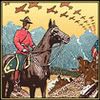
I held a piece of Canadian television and my own history today, John Hart's long rifle.
Who's....what...?
John Hart was television's "Lone Ranger" in the mid-1950's. Before that, he'd been a stuntman and "Captain Africa". But he left Hollywood in 1957 to come to Canada to star in a television series.
Hard as it may be to comprehend, long before we were dependent on government subsidies, CTF funds and regional tax benefits to survive, there was a vibrant production industry in Canada funded by private investors who actually made money.
To be honest, much of this was Hollywood getting around British and Australian quota systems that sharply limited the number of American films and TV series that entered those countries. By producing in Canada, the finished product was considered of Commonwealth manufacture and slid under the barrier.
Hart came here with fellow actor Lon Chaney Jr. ("Of Mice and Men", "The Wolfman") to star in "The Last of the Mohicans" which was loosely, as in very loosely, based on the James Fennimore Cooper novel. 39 half hour episodes were filmed in glorious B&W at an unimaginable cost of $25,000 per episode.
Hart and Chaney moved into the same apartment building in Mimico (West Toronto) which was soon besieged by kids who climbed through windows and slid down laundry chutes to meet their small and big screen idols. Both actors did the “Buffalo shuffle” almost every weekend to escape the fans and find a little culture across the border. Back then, the movie and theatre offerings in the endlessly burning city were far more diverse than they were here.
Exterior shooting was done 4 days a week on a farm just North of Pickering (East Toronto) where a frontier village, Indian encampment and 18th century fort were built. What is now endless tract housing was then virtually untouched wilderness. The Lakeshore Studios (still in use today) serviced the production one day a week for interiors.
As a kid, I was blissfully unaware of all this. All I knew was that John Hart and the show CBC broadcast every Friday at 8:00 were every bit as good as Hugh O’Brian in “Wyatt Earp”, Steve McQueen in “Wanted: Dead or Alive” or Richard Boone in “Have Gun Will Travel”, some of my other faves. It didn’t look any different, feel any different or tell its stories better or worse. And I never missed an episode.
Nobody complained that it sounded or looked like a Canadian production. Nobody had to go out of their way to make Canadian references or show a flag or mailbox to tell you where it had been shot. It wasn’t trying to sell some bureaucrat’s concept of social engineering or cultural identity. It was just a dopey TV show, burning off 30 minutes that I should’ve been using to perfect my hockey skills so I could’ve led the dog-ass Maple Leafs to a couple of Stanley Cups in the modern era.
Simultaneous to the production of “Last of the Mohicans”, 39 episodes of “Tugboat Annie” were produced here, as were another 39 of a series about truckers for a frieght company called C&A entitled “Cannonball”. Except for one or two foreign stars in each, the entire cast and crew of all three were Canadian.
Think of that! At a time when the production community was 1% of what it is now, 117 episodes of Canadian drama made it to air – perhaps more than three National networks with millions of dollars of subsidies appear capable of producing today. And that number doesn’t include all the other original dramas, comedies and variety shows that aired nightly on the CBC. It makes you wonder how much our industry has really benefited from all the government intervention, supervision and regulation.
“Last of the Mohicans” wasn’t art, but then neither is “Trailer Park Boys” or “Intelligence” or “House” or “Bones’ for that matter. Television series aren’t about art, they’re about entertaining people. One of my acting teachers once told me, “You can never set out to create art. You entertain. If you do it well, somebody else might call it art. It’s the audience’s decision, not yours.”
This afternoon, a friend and I were talking about how bleak the Canadian industry appears right now and how many restrictions there are on just being able to go out and shoot something, let alone see it broadcast. In typical Geezer fashion, we hearkened back to the good old days when everybody was busy and good looking women gave us a second look. I asked him what his first show was and he said “Last of the Mohicans”.
Turns out his father was on the crew and they needed an Indian kid for an episode. They shaved his head into a Mohawk and he did a scene with Lon Chaney Jr. When the series folded, his dad ended up with a few of the props, including John Hart’s Long Rifle.
Holding that gun was a bizarre experience, because it touched some of my earliest memories and yet connected to where I am today, just trying to entertain people but having to fill out reams of government paper and jump through endless regulatory hoops before I get the chance.
I once had a conversation with Australian director Fred Schepisi ("The Chant of Jimmy Blacksmith", "Roxanne", "The Russia House") and asked how he thought we could build an industry like Australia had over here. He looked at me dumbfounded and said, "Mate, we used you for the model" and then added, "What happened to you guys?"
I often wonder the same thing.





1 comment:
I am a child of the 70's so I would feel the same way if I were to hold Lonnie Anderson's boobs in my hands.
Post a Comment